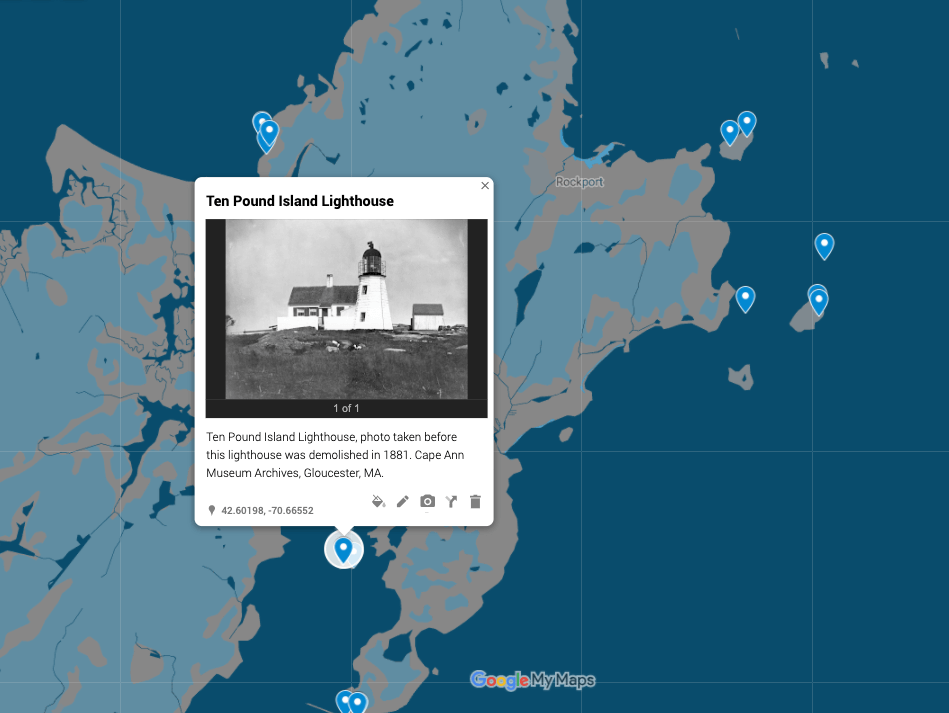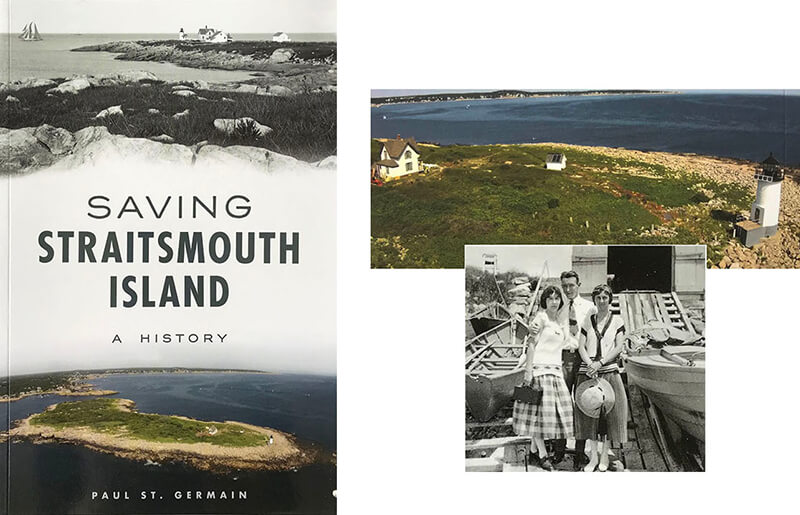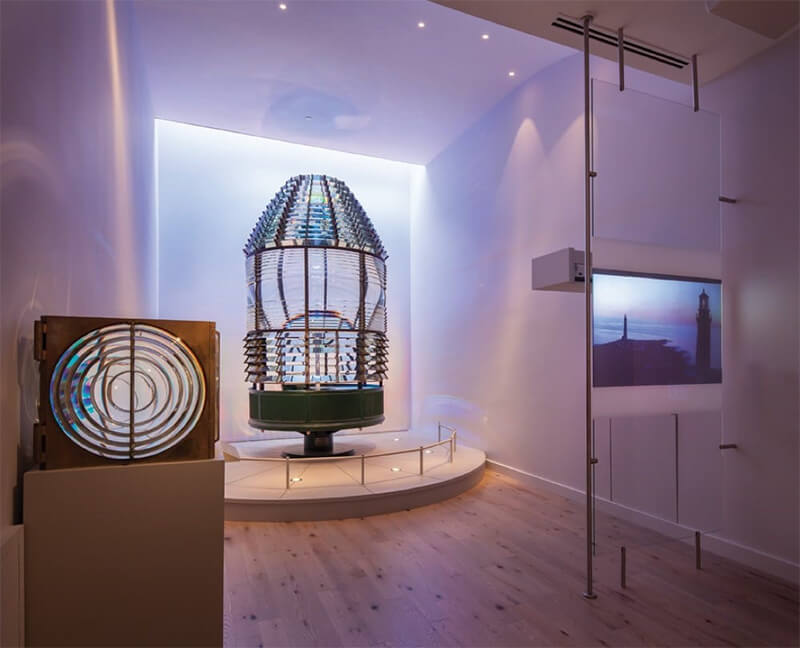
Alfred Levitt (1894-2000), Eastern Point Light, 1940s. Watercolor on paper. Collection of the Cape Ann Museum, Gloucester, MA. Gift of Don and Sherry Zowader, 2000 [acc. #2000.51].
Lighthouses
In the six years since the First Order Fresnel Lens from the south tower on Thacher Island went on display here at the Cape Ann Museum, it has become a visitors’ favorite. This unique object has inspired photographers, poets, dancers, and historians while prompting Museum staff to become more knowledgeable in the operation of 19th century lenses. By broadening our understanding of the importance of lighthouses to mariners, it has allowed us to share with visitors a richer picture of our shared past.
This week’s issue of CAM Connects gives praise to the lighthouse, the most quintessential symbol of Cape Ann and coastal New England. Through archival photographs, journals, and ship models, we take a look at a few of these important beacons. For further exploration, check out these selections from our online store. ■
Locating the Lighthouses
The Museum has an expansive collection of photography and paintings that represent all five light stations on Cape Ann. For an overview and reference point to the lighthouses discussed in this issue, this Google My Maps feature allows users to see photos of each lighthouse taken from the perspective of the artist (photographer or painter!). ■
The Keepers of the Light

Unattributed, A Southwest View of the Light House on Wigwam Point in Squam Harbour, May 25, 1801. Watercolor on paper. Collection of the Cape Ann Museum, Gloucester, MA. Bequest of Nancy E. Poland, 2017 [acc. #2017.23].
The light station at Wigwam Point in Gloucester’s Annisquam neighborhood was established in 1801 and is one of the oldest in Massachusetts. The first lighthouse tower on the site was built the same year and is featured in the early watercolor shown here. The tower was constructed of wood, octagonal in shape and had a bird-cage lantern room. Adjacent to the tower (but not connected to it) was the lighthouse keeper’s house. The first keeper of the Annisquam lighthouse was George Day who was paid $200 a year for his work. By 1872, Mr. A. G. Moore was in charge of the light station, a job, which judging from the journal he kept, now in CAM’s archives, required constant vigilance and a willingness to "burn the midnight oil."
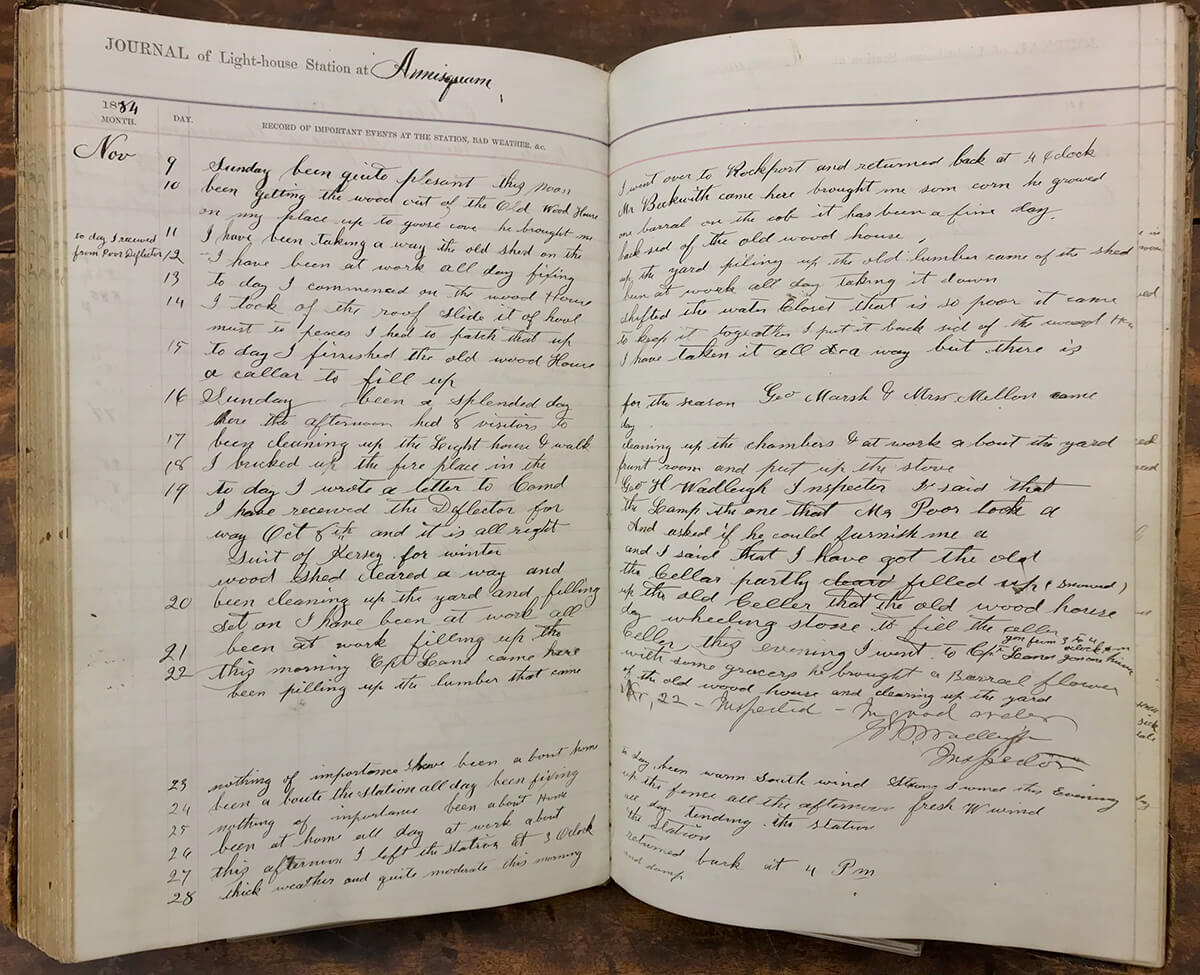
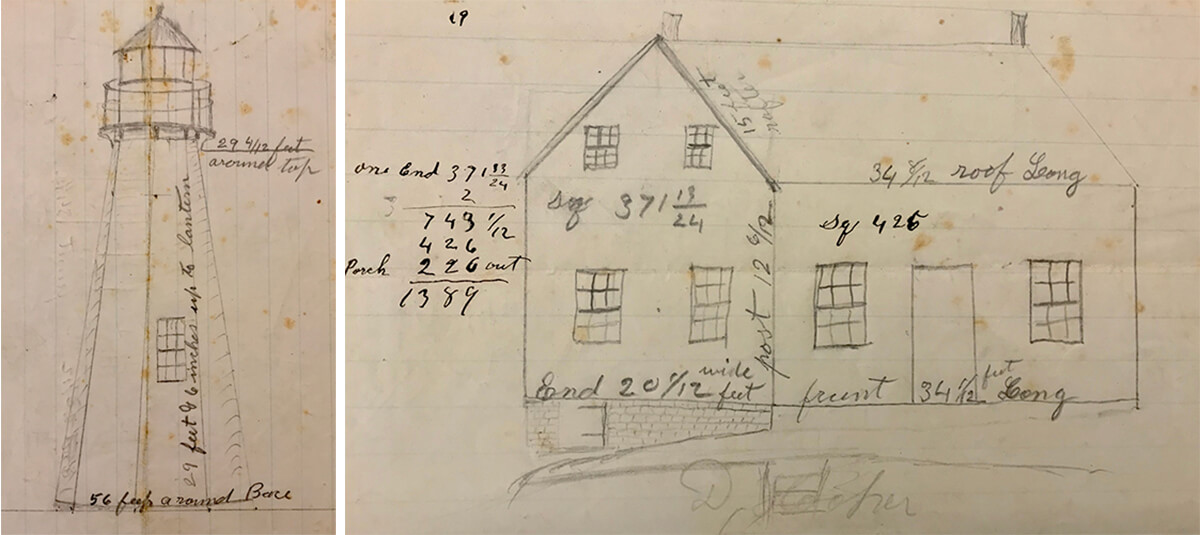
A.G. Moore; Dennison Hooper, Journal of the Keepers of the Annisquam Lighthouse, 1872-1887. Collection of the Cape Ann Museum Library & Archives, Gloucester, MA. Gift of Elliott C. Rogers, 1967 [acc. #1908].
Reproduced here are several pages from Mr. A. G. Moore and Dennison Hooper’s journal from 1872 to 1887. Moore’s primary responsibility was to keep the light burning at night and during foggy weather. This was an all-consuming responsibility which necessitated him sometimes checking the burner as many as 8 times in a single night. Moore also had to arrange his days around the light, making sure to return home from town or from visiting friends in time to light the burner before dusk. Moore could be called out at all hours of the night if his assistance was needed to rescue a mariner in distress.
Learn more about this detailed daily journal from our Stories from the Stacks page where we look at specific entries from light keeper, Dennison Hooper. ■Saving Straitsmouth Island: A History
Virtual Book Talk
Saturday, November 21st, 10:00 AM to 11:00 AM
Join author Paul St. Germain for a virtual launch of his newly released book
Just off the coast of Rockport, Straitsmouth Island has enjoyed a noteworthy history that belies the island’s small size. From the Indigenous peoples who summered there more than one thousand years ago to its discovery by Samuel de Champlain and Captain John Smith in the seventeenth century, the island has seen fishermen, shipwrecks and piracy. From 1835 to 1935, three lighthouses were built, all with fascinating stories of the keepers and their families. Thanks to tireless restoration efforts by the Thacher Island Association and Massachusetts Audubon Society, the island was recently opened to the public for the first time in 180 years. Local historian Paul St. Germain details the rich history of this unique New England treasure and the efforts to preserve both its structures and natural beauty.
Paul St. Germain has lived in Rockport for over 25 years. He has served on the board of the Thacher Island Association since 1999, and was elected president of the organization in 2002. He has written four books in Arcadia Publishing's “Images of America” series: Sandy Bay National Harbor of Refuge and the Navy, Cape Ann Granite, Lighthouses and Lifesaving Stations on Cape Ann and Twin Lights of Thacher Island. A graduate of Boston University and a recipient of a master's degree from Northeastern University, Paul has held several senior level marketing and advertising positions at major international athletic footwear and soft drink manufacturers.
Autographed copies of Saving Straitsmouth Island: A History, are available for sale at the Cape Ann Museum Gift Shop and in the Museum’s online store. ■
View more information and register online!
And for more from the author on the conservation work done at Straitsmouth Island, and to prepare for his upcoming lecture, listen to this podcast by the U.S. Lighthouse Society.
Thacher Island – Virtual Shorts Docent Blog
As an occasional “lighthouse keeper” on Thacher Island, CAM Docent, Suellen Wedmore shares her enthusiasm for both this beautiful island of 50 acres, the site of the only operating twin lighthouses in America, and for the stunning Fresnel Lens, “the invention that saved a million ships,” now beautifully housed in the Cape Ann Museum.
In this era of 24-hour weather forecasts and global positioning devices, it is difficult for us to appreciate the dangers presented to our ancestors by the sea’s storms and unseen ledges. Patriot John Hancock, with shipping interests in the area, was well aware of the dangers. He petitioned the General Court to build lighthouses on Thacher Island, the cost to be reimbursed by tolls to ship owners. Continue reading here.
While you’re there, check out the rest of the great blog posts by the Museum's dedicated team of Docents!
And for more on the type of vessel used by the name sake of Thacher Island, Anthony Thacher, continue reading below. ■
Investigating the Ill-Fated Watch and Wait
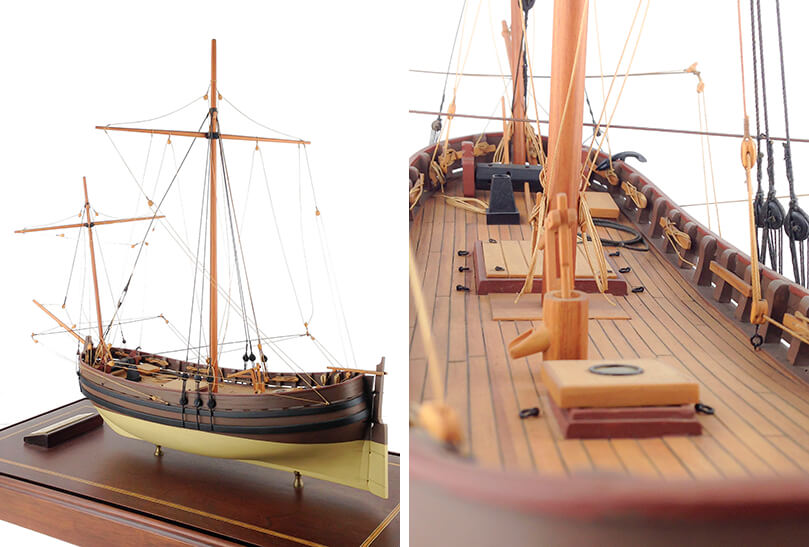
Carl Fuller, Model of a Colonial Bark. Scale: 3/8” = 1’. Collection of the Cape Ann Museum, Gloucester, MA. Gift of R. Michael Wall, 1989 [acc. #2672].
In August of 1635, a small vessel called Watch and Wait, traveling from Ipswich to Marblehead, was caught in a storm near an unnamed island off the eastern edge of Cape Ann, and was wrecked on the nearby rocks. Among the 23 passengers and crew, only two survived: a man named Anthony Thacher, and his wife, who were traveling with their four children. Although the Thachers’ shipwreck might be unexpected for such a brief voyage, the hardship and tragedy of the disaster and the naming of the wreck location for him- Thacher Island- have left a lasting memorial.
For a man whose name is now well known to many local mariners, Thacher himself was ironically no maritime expert. In a letter to his brother, Thacher described the Watch and Wait variously as both a “pinnace” and a “barque.” So which was it? William A. Baker, naval architect and historian of 17th century vessels, in his book Colonial Vessels, pointed out that Watch and Wait must have been a fully-decked vessel, given Thacher’s descriptions of activity below the deck, which was sheltered until the vessel began to break up. Barques or “barks” of that period were fully decked-over, while pinnaces built for coastal voyages were only partially decked and sometimes completely open. Using plans drawn by Baker to depict a bark of the likely size and rig of Watch and Wait, model maker Carl N. Fuller built the above model for a private collector who donated it to the Cape Ann Museum. Note the full decking! ■
Unsubscribe | Forward | View in browser
CAPE ANN MUSEUM
27 Pleasant Street, Gloucester, MA 01930
CAPE ANN MUSEUM GREEN
13 Poplar Street, Gloucester, MA 01930
Cape Ann is one of the most important places in the history of American art and industry.
The Cape Ann Museum, thanks to supporters like you, celebrates the history and remarkable contributions of this place to the cultural enhancement of our community and the world at large - yesterday, today and tomorro


